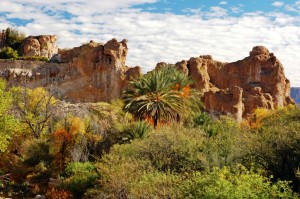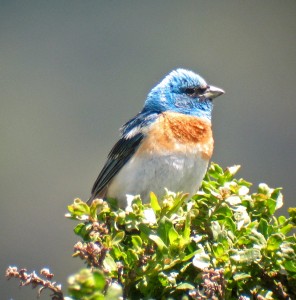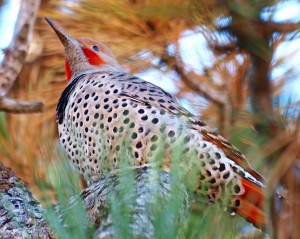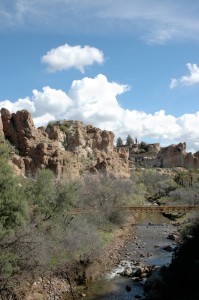Size: 4.8 square miles, 3,071 acres
Identified: 01/2004. Recognized: 05/2007
Visiting the IBA: From Phoenix: Take Highway 60 east toward Superior until you reach milepost #223. Drive takes about an hour. From Tucson: Take Oracle Road north, turn left at highway 79 and continue through and past Florence to highway 60, then turn right and continue 12 miles east. Drive takes about 2 hours.
Ownership: Boyce Thompson Arboretum and Tonto National Forest
Site Description: This IBA includes the north slope of Picketpost Mountain, foothill canyons and ridges, and two intermittent creeks. The 100-acre tract of botanical gardens open to the public is used for education, research, land conservation, and low-impact recreation.
Birds: Within the Superior Christmas Bird Count circle, this IBA is a noted bird watching spot. Rarities include Yellow-bellied Sapsucker, Brown Thrasher, Gray Catbird, and Rufous-backed Robin.
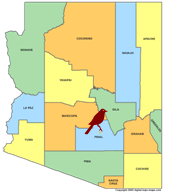
Breeding: Common-Black Hawk, Golden Eagle (Picket Post), Zone-tailed Hawk, Purple Martin, Elf Owl, Yellow-billed Cuckoo, Gilded Flicker, Costa’s Hummingbird, Broad-billed Hummingbird, Crissal Thrasher, Bell’s Vireo, Lucy’s Warbler, Yellow Warbler, Abert’s Towhee, Summer Tanager, Western Wood-Pewee, Vermilion Flycatcher, Yellow-breasted Chat, Blue Grosbeak, and Hooded Oriole.
Migration: Gray Flycatcher, Southwestern Willow Flycatcher, Olive-sided Flycatcher, MacGillivray’s Warbler, Black-throated Gray Warbler, Wilson’s Warbler, Brewer’s Sparrow, Tree Swallow, Swainson’s Thrush, Western Tanager, Lazuli Bunting, Varied Bunting, and Lawrence’s Goldfinch.
Winter: Red-naped Sapsucker, Plumbeous Vireo, Hutton’s Vireo, Western Scrub-Jay, House Wren, Marsh Wren, Ruby-crowned Kinglet, Western Bluebird, Hermit Thrush, Yellow-rumped Warbler, Green-tailed Towhee, Dark-eyed Junco.
eBird focus species: Purple Martin, Gilded Flicker, Costa’s Hummingbird, Crissal Thrasher, Bell’s Vireo, Lucy’s Warbler, Yellow Warbler and Abert’s Towhee.
Conservation Issues: Wild fire, flash flooding, and drought. Strategies: Tonto Forest has designated this segment of Arnett Creek a native fish management area. Protective management by Boyce Thompson Arboretum helps maintain the habitat quality of this IBA.
Conservation Steward: Boyce Thompson Arboretum https://btarboretum.org/directions/
Vegetation Map of this Important Bird Area:
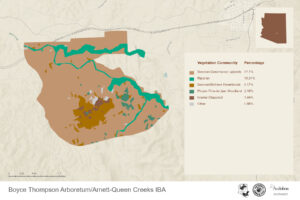
Complete eBird.org Checklist of birds Reported for Boyce Thompson Arboretum and Arnett -Queen Creeks IBA
Location: 33.2797 N: 111.1559 W
County: Pinal
Site Status: Identified 01/2004, Recognized 05/2007
Ownership: Boyce Thompson Arboretum and Tonto National Forest
Area: 4.8 square miles, 3,071 acres
Criteria: D3: State: Species in rare/unique habitat
D4vii: State: Outstanding landbird stopover
Site Description: Boyce Thompson Arboretum is located 3 miles west of Superior on Arizona highway 60. It includes the north slope of Picketpost Mountain, foothill canyons and ridges, and two intermittent creeks. The 100-acre tract of botanical gardens open to the public is used for education, research, and land conservation, and low-impact recreation (such as strolling, picnicking, picture-taking, animal-watching, etc.). Most of the IBA’s vegetation (>85%) is typical of the Arizona Upland Subdivision of the Sonoran Desert. Several plant associations associated with differences in topography and soils produce a diverse flora. Marsh-fringed Ayer Lake and intermittently flowing Queen and Arnett Creeks provide traces of wetland and riparian habitat. Rugged Magma Ridge and the slopes above the creeks stand in stark contrast to the lush vegetation within the park. The IBA formal dedication event was in conjunction with International Migratory Bird Day on May 2007.
| Vegetation Description | Hectares |
| DESERT (SCRUB) GRASSLAND | 66.99994 |
| MIXED PALOVERDE – CACTI COMMUNITIES | 1929900 |
| TEMPERATE SCRUBLAND (CHAPPARAL) | 14.12407 |
Ornithological Summary: The Arboretum provides important habitats and resources throughout the year, not just during a particular season, thus qualifying the site under the landbird criteria, “exceptional seasonal diversity of landbirds.” Probably at least partly due to the “oasis”-like nature of the area, at least 78 accidental species (5 or fewer records) and 48 casual species (more than 5, but not occurring annually) have been recorded since 1976.
| Species or group | Season | Maximum |
| Landbird Stopover | Spring and fall Passage | 5 species of conservation concern: Southwestern Willow Flycatcher, MacGillivray’s Warbler, Gray Flycatcher, Black-throated Gray Warbler, Brewer’s Sparrow. |
| Riparian Habitat | Breeding | 6 species of conservation concern: Common Black-hawk, Lucy’s Warbler, Northern Beardless-Tyrannulet, Bell’s Vireo, Broad-billed Hummingbird, Abert’s Towhee, Yellow Warbler. 1 SCS Species (Winter Period): 3 pairs |
| Red-naped Sapsucker | Winter | 3 pairs |
Of at least 275 species recorded in the IBA since the mid 1970s, 62 species of Special Conservation Status in Arizona include: Federally Endangered or Threatened (2 species), AZ Game & Fish State Threatened (15 species), AZ Partners in Flight Priority (APIF) Species (24 species), Audubon WatchList in Arizona (7 species), and U.S.F.W.S. Birds of Conservation Concern (14 species).
Many of these birds were spring and/or fall transients, but some were noted during summer and others during winter.
The site’s attractiveness to vagrants and uncommon visitors is likely to continue, as exemplified by the presence of an Olive Warbler (previously undocumented here) during the inaugural Superior Christmas Bird Count held on January 4, 2004.
Populations of some transient species periodically reach relatively high numbers, particularly on “fall-out” days. On occasion, dozens of some species and scores of others have been noted during spring and fall migration periods, thus qualifying the site also under the criteria “Outstanding Landbird stopover Site.”
This site meets two other Arizona IBA criteria:
1) Special Conservation Status Species in Arizona, including Purple Martin (APIF), Elf Owl (Audubon-Yellow listed), Gilded Flicker (Audubon-Red listed), Costa’s Hummingbird (Audubon-Yellow listed), and Crissal Thrasher (USFWS) ; plus Gray Flycatcher (APIF), Black-throated Gray Warbler (APIF, USFWS), Brewer’s Sparrow (APIF, Audubon-Yellow listed.
2) Rare or unique habitat, that hold important species or species assemblages largely restricted to a distinctive habitat or ecological community type. The Arboretum’s low-elevation riparian habitat is an exceptional example of this rare habitat in Arizona, and supports “riparian obligate” (or riparian dependent) species and species of special conservation status, breeders: Common-Black Hawk (APIF), Lucy’s Warbler (Audubon-Yellow listed), Northern Beardless-Tyrannulet (USFWS), Bell’s Vireo (Audubon-Red listed), Broad-billed Hummingbird (USFWS), Abert’s Towhee (Audubon-Yellow listed), and Yellow Warbler (USFWS). A noteworthy summer visitor, the Yellow-billed Cuckoo (APIF); migrants include Southwestern Willow Flycatcher (Endangered), MacGillivray’s Warbler (riparian dependent) (APIF) , and wintering species: Red-naped Sapsucker (riparian dependent) (APIF), and casual species, Gray Catbird (riparian dependent) (State threatened 1996).
Conservation Issues: Issues of minor concern include: necessity to maintain fencing to restrain cattle entry and to discourage hunting; expansion of mineral extraction activities on nearby Tonto National Forest lands; flooding with its deleterious removal of riparian vegetation; reduction of stream flow from upstream use; potential for wild fire in desert scrub.

